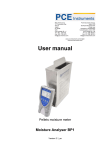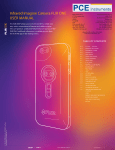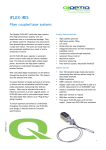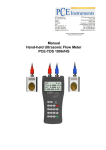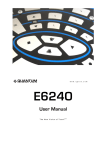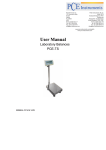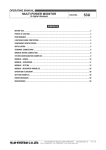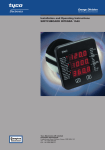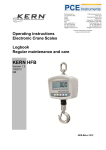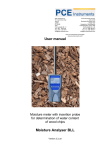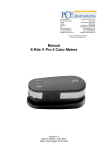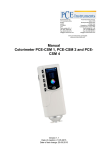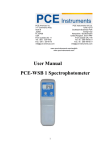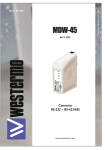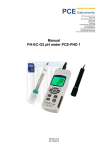Download Bedienungsanleitung PCE-MA 110
Transcript
PCE Americas Inc. 711 Commerce Way Suite 8 Jupiter FL-33458 USA From outside US: +1 Tel: (561) 320-9162 Fax: (561) 320-9176 [email protected] PCE Instruments UK Ltd. Units 12/13 Southpoint Business Park Ensign way Hampshire / Southampton United Kingdom, SO31 4RF From outside UK: +44 Tel: (0) 2380 98703 0 Fax: (0) 2380 98703 9 [email protected] www.pce-instruments.com/english www.pce-instruments.com User Manual Laboratory Balances PCE-MA 110 Version 1.0 Date of creation: 03/12/2014 Date of last change: 17.06.2015 Manual Table of contents 1 Introduction ............................................................................................................. 3 2 Safety information ................................................................................................... 3 3 Specifications .......................................................................................................... 4 4 Device description .................................................................................................. 4 4.1 Display .................................................................................................................................. 4 4.2 Keys ...................................................................................................................................... 5 5 Instructions .............................................................................................................. 6 5.1 Assembly............................................................................................................................... 6 5.2 5.2.1 5.2.2 5.2.3 5.2.4 5.2.5 Sample preparation ............................................................................................................... 6 Tools for sample preparation ..................................................................................................... 6 Single-use aluminium sample pan ............................................................................................. 7 Sample spreading ..................................................................................................................... 7 Glass fibre filter circle ................................................................................................................ 7 Practical tips ............................................................................................................................. 7 5.3 Operation .............................................................................................................................. 8 5.4 To select a memory location .................................................................................................. 8 5.5 To determine the heat-up mode ............................................................................................. 9 5.6 To determine the measurement / stop mode .......................................................................... 9 5.7 To set the drying temperature ...............................................................................................10 5.8 To set the drying / measurement time ...................................................................................10 5.9 Access to the drying parameter memory ...............................................................................11 5.10 Adjustment / calibration.........................................................................................................11 6 Contact ................................................................................................................... 12 6.1 PCE Instruments UK .............................................................................................................12 6.2 PCE Americas ......................................................................................................................12 2 Manual 1 Introduction Thank you for purchasing the PCE-MA 110 moisture determination scales from PCE Instruments. This device is an easy, quick and reliable solution to determine the moisture of various materials and works like a Darr test. This means that the weight before and after the drying process is determined and the weight loss is assigned to the moisture in percentage terms. In contrast to the Darr test, the moisture determination scales are designed for a quick moisture measurement and thus for small quantities. 2 Safety information Please read this manual carefully and completely before you use the device for the first time. The device may only be used by qualified personnel and repaired by PCE Instruments personnel. There is no warranty of damage or injuries caused by non-observance of the manual and particularly of the safety information. - The device may only be used in approved temperature and humidity ranges. Extreme temperatures, direct exposure to sunlight, extreme atmospheric humidity or moisture (e. g. wet hands) must be avoided. - The case must only be opened by qualified personnel of PCE Instruments. - The instrument should never be placed with the user interface facing an object (e.g. keyboard side on a table). - You should not make any technical changes to the device. - The appliance should only be cleaned with a damp cloth / use only pH-neutral cleaner, no abrasives or solvents. - When transporting the scales, make sure that they are placed horizontally, with the bottom side down and well-cushioned if possible. Loose attachment parts should be removed from the measuring chamber to avoid damage. It is recommended to keep the original packaging for transport. - Only use the scales with PCE accessories. - Before using the device, check the case for visible damage. If you find damage, do not use the device. - The appliance must not be used in potentially explosive atmospheres. - The MAX limits for the measurands stated in the specifications must under no circumstances be exceeded. - Only use IEC power connectors with a PE contact. - To avoid severe burns, do not touch the halogen lamps or the cover during or after the measurement. - NEVER use the scales when the cover is open. This manual is published by PCE Instruments without any guarantee. We expressly refer to our general guarantee terms, they can be found in our general terms of business. If you have any questions please contact PCE Instruments. 3 Manual 3 Specifications Weighing range Readability Heating element Drying temperature adjustable Drying time (time mode) Moisture measurement range Readability Memory Display Power supply Dimensions Weight 4 4.1 110 g (strain gauge load cell HBM K-SPL 300 g) 10 mg / 0.01 g halogen lamp / round / approx. Ø 90 mm +40 … +199 °C 1 … 99 min. adjustable 0 … 100 % 0,01 % 16 drying programmes (parameters) LCD, size of numbers 17 mm 220 V / 50 Hz 200 x 180 x 380 mm approx. 4.4 kg Device description Display - Heat-up mode (Standard / Fast / Slow) - Measurement / Stop mode (measured value consistant / user / lapse of time) - Drying temperature (40 °C … 199 °C) - Drying time / duration of drying process - Percentage of moisture - Percentage of dry weight / dry solid matter % - Grammes 4 Manual 4.2 Keys Name Function to switch the moisture determination scales on and off to start / stop the measurement to tare / leave settings to open settings to switch between absolute and relative measurement results to confirm current settings / go to next setting to return to weighing mode (short key press) / calibration (long key press) to change settings 5 Manual Instructions 4.3 Assembly Assemble all parts in the order as described in the picture above. Start with the stainless steel sheet. The notch in the side wall of the wind shield must be placed in a way that it faces the user. The handle of the sample pan lifting frame is inserted through this notch. Put the pan frame into the middle of the measuring chamber and make sure that the guide bolt merges into the guide. 4.4 Sample preparation You should always prepare only one sample for measurement. This is to avoid that the sample can exchange moisture with the environment. In case several samples have to be taken at the same time, these samples should be placed in airtight containers so that they do not modify during storage. You must spread a thin layer of the sample across the sample pan evenly to ensure reproducible results. If the sample is spread unevenly, the heat distribution in the sample to de dried will be inhomogeneous which will cause incomplete drying or a longer drying period. If there is too much of the sample in some places, the upper layers will heat up more strongly which can lead to combustions or incrustations. Excessively thick layers or potential incrustations prevent moisture from escaping from the sample. This residual moisture makes measurement results untraceable and non-reproducible. 4.4.1 Tools for sample preparation When choosing tools and instruments for sample preparation, their accuracy and reliability of measurement is important. Avoid tools that have heat-conducting characteristics, i. e. which can transfer their heat to the sample. In case of improper handling and preparation of the sample, the final result of the measurement will be faulty. 6 Manual 4.4.2 Single-use aluminium sample pan To make a measurement of the moisture content of the sample, it must be evenly spread across the sample and then inserted into the drying chamber of the moisture determination scales. Using a sample pan more often than once can falsify the final measurement result due to the adhesive residues. 4.4.3 Sample spreading Warning: The samples must not exceed 8 mm in thickness and a diameter of 90 mm. If you exceed the maximum height of the sample, this can cause combustions or incrustations of the sample. The sample should e spread across the sample pan as evenly as possible, optimally in layers that are 2 … 5 mm thick. Please make sure that the temperature sensor inside the cover of the moisture determination scales does not touch the sample as this would falsify the result. Solids: - Spread powdery and granular samples evenly across the sample pan. - Crush coarse-grained samples with a mortar or a grinder. When doing so, avoid any addition of heat as this results in moisture loss. Liquids: For liquids, pastes or melting samples it is recommended to use a glass fibre filter. The glass fibre filter has the following advantages: - even spreading due to capillary action - no drop formation - quick evaporation due to wider surface 4.4.4 Glass fibre filter circle When drying liquids, pastes or melting samples, a glass fibre filter circle should be used. These filters ensure even spreading of liquids across the sample pan and prevent combustion of solids. 4.4.5 Practical tips Before starting the measurement, place the sample pan and where applicable the glass fibre filter circle on the pan tripod and tare so that only the weight of your sample is considered. If you wish to make several measurements in a row, make sure that the temperature remains the same all the time and that the evaporation already takes place while the cover is closed. Solution: You can either let the drying chamber cool down or accept the measurement deviations and start the following measurement as soon as possible. 7 Manual 4.5 Operation When you switch the moisture determination scales off and back on, the drying parameters last used are saved. These are shown on the display. Prepare the sample now and put it into the drying chamber. You can start the measurement by pressing the key. After you have finished the measurement, the measurement values remain saved until you delete them. You can switch between the weight indication / dry content indication in % and the moisture content indication in % by means of the key. After measuring, the measurement values last determined must be deleted from the memory. To do so, press the key. CAUTION: Before you place the next sample, make sure that 0.00 g is displayed. If this is not the case, apply the key. In case different drying parameters are necessary as the material samples are so different, the moisture determination scales offer up to 16 memory locations. In each memory location, you can save the heat-up mode / configured criterion / drying temperature as well as drying time where applicable. 4.6 To select a memory location Press the key. On the left-hand side of the display, a flashing number appears to represent the memory location. You can retrieve up to 16 different memory locations by means of the arrow keys drying parameters appear in the display along with the chosen memory location. . The saved If you want to use the drying parameters of a memory location, press . The moisture determination scales adopt the drying parameters and you can start with your measurement. However, if you would like to save other drying parameters in a memory location, you must select the memory location and confirm with the key. 8 Manual 4.7 To determine the heat-up mode After selecting the memory location, the drop symbol flashes in the upper part of the display. Here, the user can choose between three heating rates. Standard heat-up mode This mode is set as default and is adequate for most samples. In this mode, 120 °C are reached after approx. 4 minutes. Fast heat-up mode This mode is adequate for samples with a high moisture content. In this mode, 120 °C are reached after approx. 1 minute. CAUTION: In this heat-up mode, there might be temporarily higher temperatures in the measuring chamber as the sensor and the control need some time to regulate the temperature. Slow heat-up mode This mode is adequate for samples with a low moisture content. In this mode, 120 °C are reached after approx. 8 minutes. CAUTION: In this mode, it is important that the drying time is adapted to the sample and to the drying mode as otherwise the drying process might be stopped (time has run out) even though there is still some residual moisture in the sample. You can choose the appropriate heat-up mode via the To confirm the chosen heat-up mode, press the arrow keys. key. 4.8 To determine the measurement / stop mode After selecting the heat-up mode, the bar symbol flashes in the upper part of the display. Here, the user can select between three measurement and stop modes. Constant measurement value This measurement / stop mode ends the measurement automatically when the measurement value is constant. Constant measurement value means that the moisture determination scales cannot detect a change in weight which is above 2 mg. CAUTION: In this mode, a time setting of the measurement is not possible. The drying time might be longer than 99 minutes. 9 Manual Manual / user stop mode In this measurement / stop mode, the measurement can be ended by the user. To do so, press the key. CAUTION: In this mode, the sample can easily combust, depending on the chosen temperature. For this reason, only use this mode under constant observation. The advantage of this measurement is that you can let the sample dry for a longer period of time so that even moisture can escape which is very deep in the sample. Time stop mode This measurement / stop mode ends the measurement automatically when the set measurement / drying time is up. CAUTION: The maximum measurement / drying time that can be set is 99 min. arrow keys. You can select the measurement / stop mode by means of the To confirm the chosen measurement / stop mode, press the key. 4.9 To set the drying temperature After selecting the measurement / stop mode, the temperature indication flashes in the upper part of the display. You can set the drying temperature by means of the made in 10 °C steps. After confirming by pressing the arrow keys. The first setting can be key, it is possible to set in 1 °C steps. CAUTION: During the temperature regulation, temperature decreases of up to 4 °C are possible. When you stipulate the temperature, make sure that the sample does not combust as this would falsify the moisture measurement value. 4.10 To set the drying / measurement time (only in time stop mode) Depending on the measurement / stop mode you have chosen, the time indication flashes in the upper part of the display. You can set the drying / measurement time by using the To confirm the chosen drying / measurement mode, press the arrow keys. key. CAUTION: The maximum drying / measurement time you can set is approx. 99 min. 10 Manual 4.11 Access to the drying parameter memory key. To access the drying parameter memory, press the On the left-hand side of the display, a flashing number appears which represents the memory location. The user can retrieve up to 16 different memory locations by means of the saved drying parameters appear on the display with the chosen memory location. If you would like to use the drying parameters of a memory location, press the arrow keys. The key. 4.12 Adjustment / calibration The moisture determination scales consist of a weighing unit and a drying chamber. The moisture content is determinate on the basis of the weight loss. This can be easily traced by means of a rule of three. CAUTION: The PCE-MA 110 moisture determination scales have a higher internal weighing resolution than shown on the display. The scales take the higher weighing resolution, which is not visible for the user, as basis for calculation. For this reason, it is possible that there are deviations behind the decimal point when you recalculate. The weighing unit can be adjusted with an external test weight of 100 g (at least M1). Check the arrangement of the moisture determination scales (low-vibration and arranged by means of the level). An adjustment of the weighing unit should only be carried out after a warm-up time of approx. 30 minutes. To do so, press and hold the key for 6 seconds. The display of the scales will show “-CAL-”. After “-CAL-”, “100.00 g” will flash on the display of the moisture determination scales. Now place the 100 g calibration weight in the middle of the weighing platform. The display will then change from “100.00 g” to “====”. When the display changes from “====” to “100.00 g” again, you must remove the weight from the weighing platform. After that, the display will show “===” again and change to “0.00 g” independently. The adjustment of the scales is now finished. 11 Manual 5 Contact If you have any questions about our range of products or measuring instruments please contact PCE Instruments. 5.1 PCE Instruments UK By post: PCE Instruments UK Ltd. Units 12/13 Southpoint Business Park Ensign Way, Southampton Hampshire United Kingdom, SO31 4RF By phone: Support: 02380 987 035 Sales: 02380 987 030 5.2 PCE Americas By post: PCE Americas Inc. 711 Commerce Way Suite 8 Jupiter 33458 FL USA By phone: Phone: 410-387-7703 Fax: 410-387-7714 12












